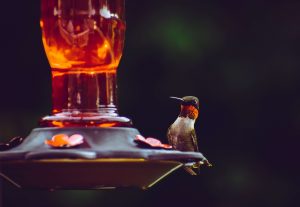 Some people refer to hummingbirds (“hummers” to birdwatchers) as “winged jewels,’ which is no surprise, given their small size, the males’ brilliant iridescent colours, and the way they flit about.
Some people refer to hummingbirds (“hummers” to birdwatchers) as “winged jewels,’ which is no surprise, given their small size, the males’ brilliant iridescent colours, and the way they flit about.
There are 5 hummingbird species in Canada, but only one, the Ruby-throated Hummingbird, in Ontario. Males have bright red throats, iridescent green backs, wings, and tails, and a white belly. Females are similar but lack the red throat and their green is less brilliant (the better to stay camouflaged on the nest).
These remarkable critters beat their wings an amazing 40-60 times per second, take about 250 breaths per minute, and have heart rates up to 1,260 beats per minute when flying. All this activity means they burn 11 calories per minute, so they have to feed almost constantly, eating (or drinking) half their body weight each day. In their book, Up North (a fantastic and informative read, by the way), Doug Bennet and Tim Tiner did some silly math to put this into a human scale and suggest that a 176-pound male would have to eat 45kg of Smarties and drink 5 cases of beer each day to fuel the same metabolic rate!
Ruby-throats will be returning to Peterborough from their Central American wintering grounds soon, if not already (many fly across the Gulf of Mexico in a single flight en route!). There are very few flowers in bloom when they arrive, and they rely heavily on tree sap from Yellow-bellied Sapsucker and other woodpecker holes.
You can support hummingbirds in their quest for calories while enhancing the beauty of your yard by setting up a hummingbird feeder. When purchasing a new hummingbird feeder, consider a model with devices, such as moats, to exclude ants and bees, unless you want to support the bees, as well. Note that hummingbirds are very territorial when it comes to their feeding sites and will aggressively chase bees away.
Boil 4 parts water and 1 part table sugar. Let it cool. Fill the feeder when needed, and store surplus in the fridge for 3-4 weeks. There’s no need to add food colouring: you can purchase feeders with red reservoirs to help them find the feeder. This mixture will ferment and become toxic quickly on hot, sunny days, so be sure to change it regularly. Be sure to clean it occasionally with hot water and vinegar, and if you ever notice mould, add a drop or two of bleach.
Keep your eyes open for the male’s courtship display. Males fly side-to-side in a fast, deep arc, like a pendulum swing, while chattering away.
Learn more from these Garden Gate episodes:
- Episode 114 – Tips to attract hummingbirds to your garden
- Episode 91 – Orioles and Hummingbirds
If you really want to get into supporting hummingbirds, this Canadian Wildlife Federation page offers a lot of valuable tips on plant selection.
